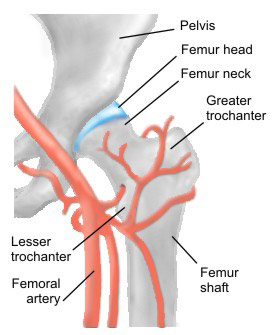The hips, along with the knees, are the large weight-bearing joints that allow you to walk, sit, bend and turn. As the body’s most flexible, free-moving joint, a healthy hip can move back and forth, swing from side to side and perform twisting motions. This remarkable range is possible because of the hip joint’s ball-and-socket design.
The upper part of the femur (thigh bone) narrows down to a “neck” that ends in a round, ball-like “head”. On the pelvis, a number of bony plates fuse together during growth to create a cup-like socket, called the acetabulum, into which the femoral head fits snuggly. Dense cartilage lines the acetabulum and coats the femoral head, providing shock-absorption and friction-free glide surfaces as the joint rotates through its range of motion. Strips of tough, flexible tissue, called ligaments, form a capsule around the junction of ball and socket, as well as lashing the femur to the pelvis. An overlay of different muscles and tendons that attach to the pelvis and bony points on the femur provide the mechanical leverage necessary for motion.

Hip Dysplasia
Hip Fractures
Total Hip Replacement
Surgery stops the pain and sets you free
Visit our Patient Information Resources page for more information and resources.

